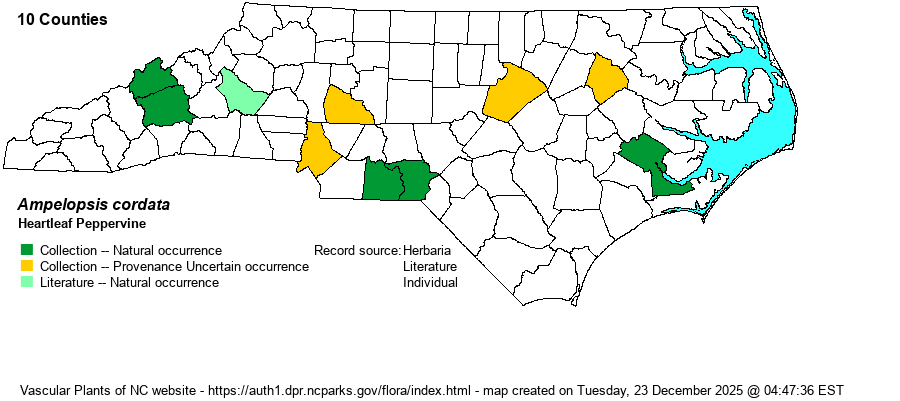| Author | Michaux | |
| Distribution | Widely scattered in the low Mountains (apparently only near the French Broad River) and in a few parts of the Piedmont (Pee Dee River of Anson and Richmond counties) and Coastal Plain. Probably not of natural occurrence in the four counties shaded orange. Owing to identification difficulties and uncertainty of provenance, iNaturalist photos are not incorporated onto the range map.
This is primarily a species of the Midwestern and Mississippi drainage states, from eastern KS and southern OH south to central TX and AL. Widely scattered east to eastern VA and the FL Panhandle. As there are apparently native populations in southeastern VA, as well as over much of the SC Coastal Plain, it has the potential to be found in much of the NC Coastal Plain. | |
| Abundance | Rare along the French Broad River in the Mountains; locally rare in the southern Piedmont and eastern Coastal Plain, and very rare in the northeastern Piedmont and adjacent Coastal Plain (where the range is unsettled and hereby considered of uncertain provenance). This is an NC Watch List species. | |
| Habitat | This is a vine of rich bottomland forests and levees, often where there are openings or disturbed places in floodplains. It seems to prefer higher pH soils. Most vines favor light gaps in forests and thickets, and this species is no exception. And, because it can occur in clearings, some natural populations might appear to be non-native at first glance. |
| Phenology | Blooms and fruits from May to July. | |
| Identification | This is a high-climbing deciduous vine with rather large triangular to heart-shaped leaves, reaching 3-5 inches long and wide. The alternate leaves are strongly serrated, with an acuminate tip; there may be small lobes on each side of the leaf, but it is not strongly tri-lobed like many grapes are. The leaf base is truncate to very slightly cordate. There may be scattered tendrils opposite some leaves, but the vine climbs by a twining stem and not by grasping of other vegetation with tendrils. As with Nekemias arborea, the small greenish flowers grow in large clusters in leaf axils, but the berries -– in this species blue –- are much more conspicuous. There are a number of similar species to confuse with this species. In general, grapes (genus Vitis) have branched tendrils and usually have larger leaves with distinct lobes (three); check Weakley (2018) and other references for further differences. Also, the exotic Ampleopsis glandulosa is often common locally; it has three-lobed leaves and the berries are more colorful (often purple). Therefore, be very careful about identification of this rather rare species in NC, as there are a number of similar species. | |
| Taxonomic Comments | None
| |
| Other Common Name(s) | Raccoon-grape, False-grape, Heartleaf Ampelopsis. Note that N. arborea is essentially always known as Peppervine, without a modifier name, such as Eastern Peppervine or Common Peppervine. This is a naming issue, allowing confusion of the two species with the word “Peppervine”. | |
| State Rank | S2 | |
| Global Rank | G5 | |
| State Status | W7 | |
| US Status | | |
| USACE-agcp | FAC link |
| USACE-emp | FAC link |

